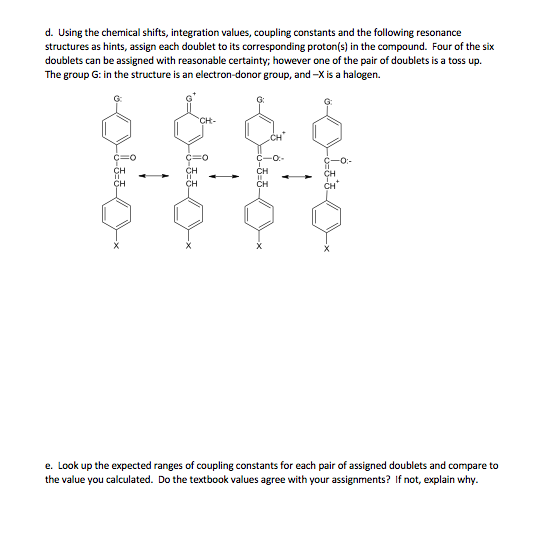Some protons resonate much further downfield than can be accounted for simply by the deshielding effect of nearby electronegative atoms.
Vinylic protons chemical shift.
Tetramethylsilan tms ch 3 4 si is generally used for standard to determine chemical shift of compounds.
This is not surprising since the proton is not only vinylic but it is also alpha to a carbonyl group.
Chemical shift d type of proton examples chemical shift in ppm comments.
The chemical shifts of aromatic and vinylic protons.
Predict the chemical shifts of the protons in the following compounds.
We ll consider the aromatic proton.
And even though the signal can be in the range from 1 6 ppm it is usually in the downfield end of this spectrum.
0 8 1 5 ppm alkane c h.
In other words frequencies for chemicals are measured for a 1 h or 13 c nucleus of a sample from the 1 h or 13 c resonance of tms.
Table of characteristic proton nmr shifts type of proton type of compound chemical shift range ppm rch 3 1 aliphatic 0 9 r 2 ch 2 2 aliphatic 1 3 r 3 ch 3 aliphatic 1 5 c c h vinylic 4 6 5 9 c c h vinylic conjugated 5 5 7 5 c c h acetylenic 2 3 ar h aromatic 6 8 5 ar c h benzylic 2 2 3 c c ch 3 allylic 1 7 hc f.
Vinylic protons those directly bonded to an alkene carbon and aromatic benzylic protons are dramatic examples.
Tetramethylsilan tms ch 3 4 si is generally used for standard to determine chemical shift of compounds.
However this particular orientation makes such a large contribution that it dominates the chemical shift.
Chemical shift is associated with the larmor frequency of a nuclear spin to its chemical environment.
Typical h nmr shift ranges.
This is a general trend add approximately 0 2 0 4 ppm for each additional alkyl group.
Table 13 3 typical values of chemical shifts type of proton approximate 8 type of proton approximates 0 9 alkane ch methyl alkane ch methylene 1 7 1 3 c c ch ph h aromatic ph ch benzylic 7 2 alkane ch 1 4 23 mething le r c aldehyde 9 10 ch methyl ketone 2 1 2 5 cec h.
Notice that the proton closest to the carbonyl group is at a higher chemical shift than the proton in cyclohexene 6 05 ppm for cyclohexenone vs.
1 h nmr chemical shifts.
The chemical shift of protons connected to heteroatoms the second group of protons giving signal in this region is the ones bonded to heteroatoms such as oxygen and nitrogen.
C h acetylenic 2 3 ar h aromatic 6 8 5 ar c h benzylic 2 2 3 c c c h.
1 h nmr chemical shifts.
The chemical shift of a vinylic proton is an average over all orientations of the molecule.
Splitting between vinylic protons in alkenes depends strongly on the geometrical relation.
Table of characteristic proton nmr chemical shifts.
Chemical shift is associated with the larmor frequency of a nuclear spin to its chemical environment.
We know that a proton alpha to a carbonyl group is pulled downfield.

